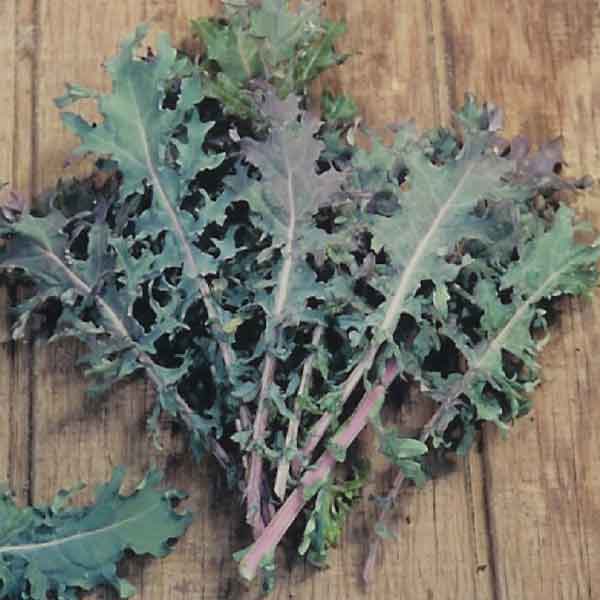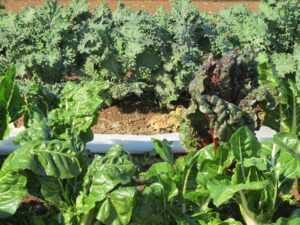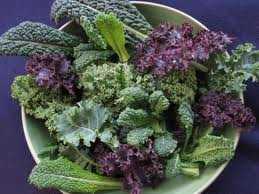Hail to the Mighty Kale!
For the past few weeks now, you have been receiving these strange greens, which are surely a mystery to some Chubeza clients. They look like this:
These are kale, aka borecole–a magical vegetable with super powers, albeit bitter, tough, and possessing a taste that must be acquired. But I assure you, after you overcome those obstacles and fall in love, there is no looking back. You’re addicted.
Kale belongs to the venerable Brassica oleracea family, which is making its grand autumn entry to your boxes as we speak. Brassica oleracea are the makers of broccoli, cabbage, Brussels sprouts, cauliflower and kohlrabi. Of all the family members, kale is the most primitive and definitely the toughest. It survives beautifully in all types of earth, provided it enjoys good drainage. Kale is really the primal cabbage, the first of its genus before it developed into the leaves of a cabbage head, the inflorescence of broccoli or cauliflower or the thickening of its stem to kohlrabi or Brussels sprouts. All these developments occurred in the Brassica family over the cultivation of farming, as a result of farmers’ meticulous choices. But kale remained as is, and it’s a good thing, too! Kale’s Latin name is Brassica oleracea acephala, meaning “a headless cabbage.”
Kale is one of the first in its family to herald the coming autumn and cold weather, and then remains with us for the whole season! Cold and wintery weather does not deter Mr. Kale. On the contrary, he thrives well in the cold, and even gets sweeter. Pests and diseases are not attracted to kale, and when they are, they hardly faze him. Last year, our kale fell victim to an aphid attack, which was pretty scary. At some point all its youthful leaves were covered with the tiny black creatures. We thought this was goodbye, but a vegetable like kale does not go gently into the good night. When cold weather came, scaring away the aphids, the kale experienced a miraculous recovery. The leaves revived to renew the crop with a fresh, strong and completely clean yield.
In this candid shot from our field, the kale is posing right next to his friend, Swiss chard. In the boxes, they usually alternate (Thank you, Chana Netzer, for the beautiful photograph):
This strength is evident in kale’s health virtues. It is considered to be one of the healthiest of foods, containing a huge quantity of Vitamin A, in addition to good amounts of calcium, Vitamin C, folic acid, Vitamin K, lutein, dietary fibers and cancer-fighting antioxidants. To make a long list short, it’s good for our eyes, bones, digestion, and fortifying the body against various diseases.
And, over the years, kale has protected those who have grown it in their gardens: saving frozen Europeans from starvation in frosty winters when nothing else would grow, and black slaves in the U.S. south who grew it easily in their yards and cooked kale with scraps of meat from their white master’s kitchen to stave off malnourishment. During WWII, kale was promoted in the Dig for Victory campaign, aimed at encouraging the urban Brits to plant gardens anywhere possible to produce their own food for times of siege and distress. Today, once more, within the leanness of our opulence, among all the processed and preserved food, kale is gaining new vigor in a host of recipes of all types.
In Israel, kale is also gaining popularity. When I wrote about it twelve years ago in the first (!) Chubeza newsletter, I had no Hebrew sources and all the recipes had to be translated. When I researched kale this week, I found a variety of excellent “local” suggestions for its yummy and joyful use. We have not lost hope. And truly, kale is a multi-versatile vegetable. Use it as a stuffing leaf, in a filling, wintery soup, in a rich salad, in veggie fritters, as baked chips, processed into green crackers, in a dish of greens, and even a green shake (But in a shake blend it in gradually. Its bitter flavor is dominant and takes some getting used to…) We have many recipes for you today in our recipe section, but you can find them almost anywhere.
Melissa, our neighbor from Kibbutz Gezer (and a loyal member of Chubeza from Year 1) sent me a great story about Gezer’s attempt to grow kale almost 15 years ago… (Hebrew) True, these unusual leaves have been through a lot over the past decade, from being the food of weirdos to starring in haute cuisine and upscale markets.
Kale comes in a bevy of varieties differing in color (from dark to light green, pink and purple), size and texture (frizzled, smooth, curly) and somewhat in flavor. Here’s a picture showing the array:
After experimenting with a number of types of kale over Chubeza’s first year, we have been growing the Red Russian variety for the past eleven years. The title was given in America, where it was brought by Russian merchants. Its purplish-red hue completed the picture. This species has softer thinner leaves which are less bitter and thus “user friendly.”
So true, for those of you who are not yet acquainted with kale, it requires some getting used to, some risk-taking, some searches for the right recipe, and as always, an open mind. But those who open their hearts and mouths to this vegetable will find it to be good and nutritious and healthy. Definitely worth it!
Wishing you a week of experimenting, of daring to take a chance, and of great flavors. And most of all – may kale regale!
Alon, Bat Ami, Dror, Yochai and the entire Chubeza team
_______________________________
WHAT’S IN THIS WEEK’S BOXES?
Monday: Lettuce, coriander/ mint (nana), slice of pumpkin, radishes/turnips/daikon, potatoes/carrots/ tomatoes, Swiss chard/kale/New Zealand spinach, cucumbers, sweet potatoes, baby greens (mesclun mix)/mizuna/totsoi/arugula, beets/fennel/ kohlrabi. Small boxes only: eggplant/bell peppers.
Large box, in addition: Mustard greens, leeks, Thai beans/okra, Jerusalem artichokes/ corn
Wednesday: Lettuce, coriander/ mint (nana), slice of pumpkin, radishes/turnips/daikon, eggplant/carrots/ tomatoes, Swiss chard/kale/New Zealand spinach, cucumbers, sweet potatoes, baby greens (mesclun mix)/mizuna/totsoi/arugula, potatoes/bell peppers, fennel/ kohlrabi
Large box, in addition: beets, leeks, Thai beans/Jerusalem artichokes.
And there’s more! You can add to your basket a wide, delectable range of additional products from fine small producers: flour, fruits, honey, dates, almonds, garbanzo beans, crackers, probiotic foods, dried fruits and leathers, olive oil, bakery products and goat dairy products too! You can learn more about each producer on the Chubeza website. Our order system also features a detailed listing of the products and their cost. Make an order online now!



